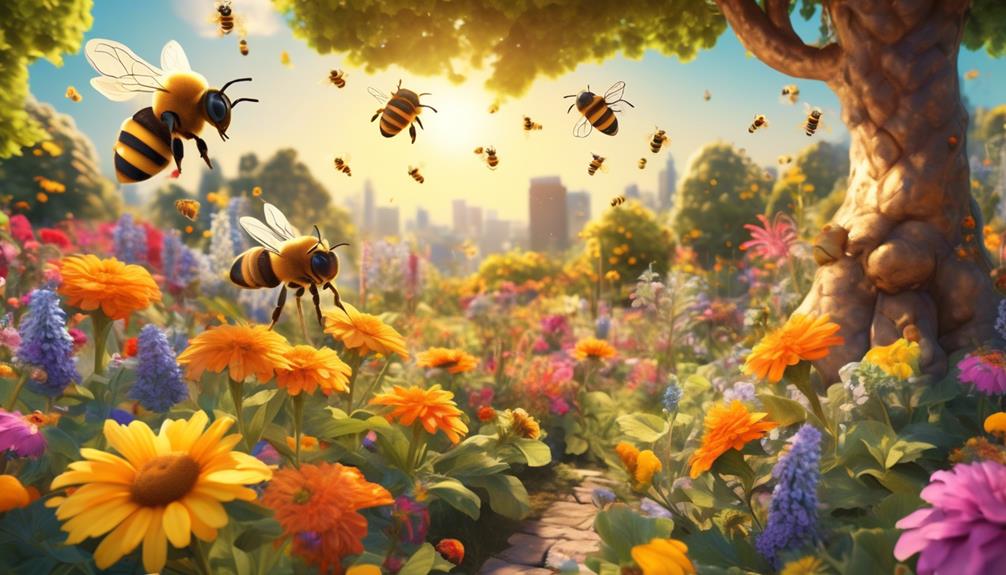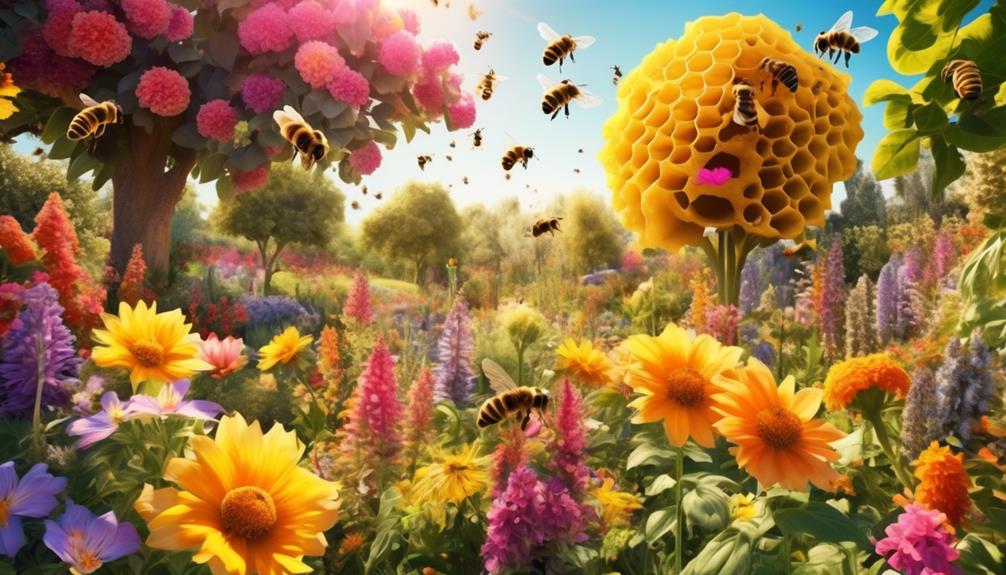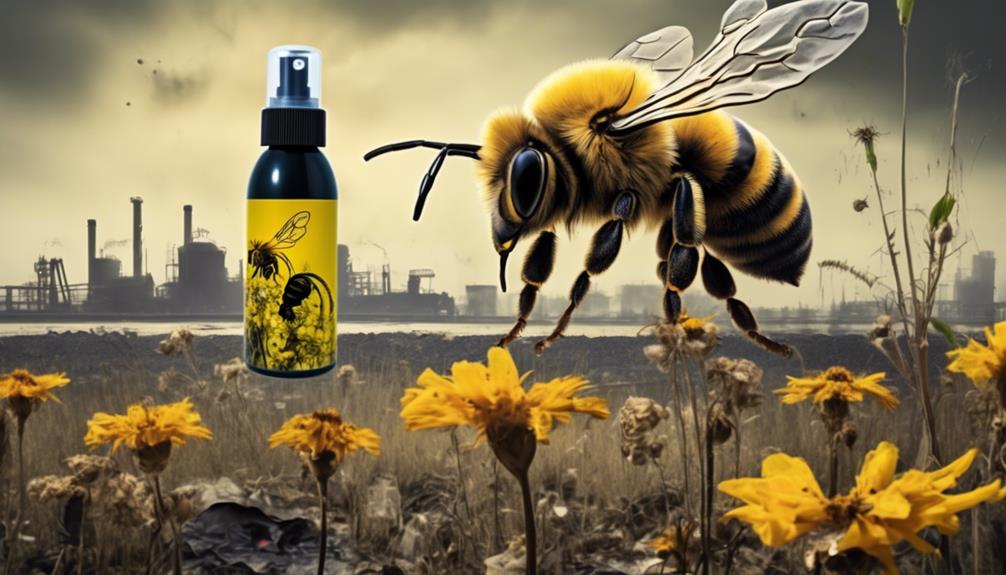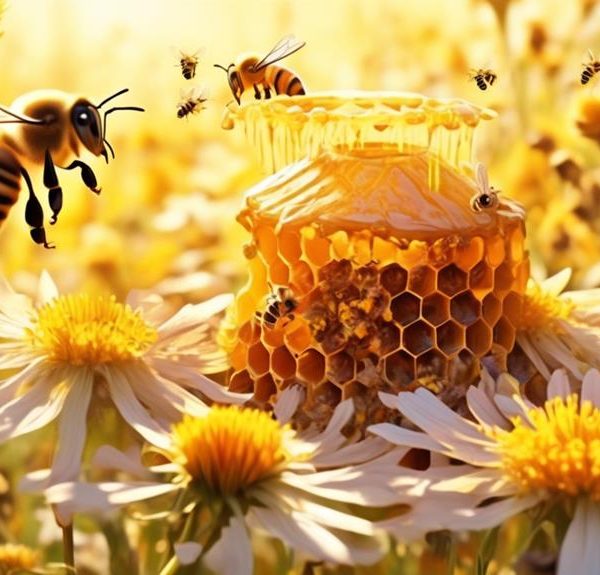Yearning to understand the environment? Discover how bees, these tiny, often overlooked creatures, play an indispensable role in sustaining our world.

Why Bees Are Important to the Environment?
You might think that bees are just pesky insects that interrupt your summer picnics, but you couldn't be more off the mark. In truth, bees play an indispensable role in our environment.
They are pollinators, and without them, many of the foods you eat daily wouldn't exist. You're probably wondering how these tiny insects, often considered a nuisance, have such a profound impact on our daily lives.
Well, stick around, and you'll discover the surprising and intricate ways in which bees, these unsung heroes, keep our world spinning.
Key Takeaways
- Bees are primary pollinators, facilitating the reproduction of over 85% of the world's flowering plants.
- Without bees, there would be a significant reduction in the variety and abundance of fruits, vegetables, and nuts.
- Bees contribute to biodiversity by supporting a vast array of life in ecosystems.
- The decline of bee populations poses an economic threat that needs urgent attention.
The Role of Bees in Pollination

You mightn't realize it, but bees, nature's tiny pollination powerhouses, play a pivotal role in the propagation of plants, directly impacting our food supply and the overall health of our environment. Acting as nature's primary pollinators, they're an integral part of the ecosystem, facilitating the reproduction of over 85% of the world's flowering plants, according to a report by the Food and Agriculture Organization.
You'd be surprised to know that a single bee can visit up to 5,000 flowers in a day, collecting and spreading pollen as it goes. This process is critical for the survival of many plant species which wouldn't reproduce without bee pollination. That means that without bees, we'd see a significant reduction in the variety and abundance of fruits, vegetables, and nuts we consume daily.
Not just that, bees are also crucial for pollinating crops that feed livestock, meaning our meat and dairy supply would also be jeopardized without them. In fact, research estimates that bees' pollination services are worth a whopping $15 billion annually to the U.S. economy.
Bees and Biodiversity

Beyond their crucial role in pollination, bees significantly contribute to biodiversity, maintaining balance and health in ecosystems worldwide. As you walk through a park, you mightn't realize just how much you owe to these industrious insects. They're not just making honey; they're supporting the vast array of life that makes up your local environment.
Many plant species rely exclusively on bees for pollination. Without them, these plants wouldn't produce fruit or seeds, leading to a loss of both plant and animal species. This is because many animals depend on these fruits and seeds for food. You see, it's a domino effect; when bees disappear, it impacts the entire food chain.
Research shows that in areas where bees are thriving, there's a higher diversity of plant species. This is because bees, especially wild ones, pollinate many different types of plants, ensuring a mix of species. This is key for a healthy, resilient ecosystem.
Economic Impact of Bees

While the ecological value of bees is undeniable, it's also worth noting their substantial contributions to the economy. Bees, as significant pollinators, play a crucial role in agriculture, which in turn impacts economic stability globally.
Imagine your favorite fruits, vegetables, or even the coffee you enjoy every morning. These are all made possible by the hard-working bees as they pollinate around 70 of the 100 crop species that feed 90% of the world. Without bees, you'd see a dramatic decrease in the quality and quantity of these products, leading to a potential food crisis.
In fact, bees' economic impact is so profound that it's estimated to be around $20 billion annually in the U.S alone, and about €153 billion in Europe. These figures represent the value of the crops that bees pollinate. It's clear that the decline of bee populations is more than just an environmental issue; it's an economic threat that needs urgent attention.
Threats to Bee Populations

Despite their immense importance to both the environment and economy, bees are facing numerous threats that jeopardize their survival and, consequently, our own food security. Over the years, you've probably heard about the decline in bee populations, but do you know what's causing it? Research shows that it's a complex issue with multiple contributing factors.
Firstly, habitat loss due to urbanization, deforestation, and changes in land use have greatly reduced bees' access to the diverse flowers they need for survival. Pesticides, particularly neonicotinoids, are another serious threat. They're toxic to bees, impairing their memory and navigation abilities, even at low concentrations.
Disease and parasites, such as the Varroa mite and Nosema fungus, also play a role in bee population decline. These pests weaken bee colonies, making them more susceptible to other threats.
Lastly, climate change exacerbates all these problems, disrupting bees' seasonal behaviors and geographical distribution.
In essence, the threats to bees are interrelated, escalating the severity of each other. It's crucial that you understand these issues as they don't just affect bees; they impact our entire ecosystem and food supply. So, it's not just about saving bees, it's about preserving our future.
Ways to Protect Our Bees

Armed with an understanding of the threats facing bees, it's essential that you actively engage in strategies and practices to help safeguard these vital pollinators.
You can start by planting a bee-friendly garden. Diversify your plantings to include native species that bloom at different times of the year. Bees need a continuous supply of nectar and pollen, and a varied diet improves their health and resilience.
Avoid using pesticides, especially neonicotinoids, which are particularly harmful to bees. If pest control is necessary, opt for organic methods and apply them at night when bees are less active.
You can also provide habitat for bees. Leave some areas of your garden untidy, with piles of leaves or logs where bees can nest and overwinter. Consider installing a bee hotel for solitary species.
Support local beekeepers by buying local honey and other beehive products. This directly contributes to the economic viability of beekeeping, encouraging beekeepers to maintain healthy hives.
Frequently Asked Questions
What Is the Lifespan of a Typical Bee?
You're curious about the lifespan of a typical bee. It's quite fascinating!
Worker bees, the most common, live 5-6 weeks during summer, while drones live up to 4 months.
The queen bee outlives them all, reaching up to 5 years!
Lifespan varies depending on the bee's role, species, and environment.
Isn't nature's design incredible?
Remember though, their lifespan doesn't diminish their critical role in pollination and our ecosystem.
Are There Any Species of Bees That Do Not Sting?
Yes, there are several species of bees that don't sting.
Most notably, male bees, known as drones, lack a stinger entirely.
Additionally, stingless bees, a subgroup of honey bees found mostly in tropical and subtropical regions, can't sting.
They're vital for pollination just like their stinging counterparts.
However, don't mistake their inability to sting as a lack of defense.
They can bite and some even release an irritating substance.
How Do Bees Communicate With Each Other?
Bees communicate primarily through dance and scent.
When a worker bee finds a rich source of nectar, she'll return to the hive and perform a 'waggle dance.' This dance communicates the direction and distance of the nectar source.
Additionally, bees release pheromones, or chemical signals, to alert others in the hive of danger or to guide them to a food source.
What Is the Process of Honey Production by Bees?
You're curious about honey production? Well, it's a fascinating process.
Bees collect nectar from flowers, which they store in their honey stomachs. Back at the hive, they regurgitate the nectar to worker bees who chew it, breaking down the complex sugars.
The resulting substance is deposited into honeycombs and fanned by bees' wings to evaporate excess water. Lastly, the bees seal the honeycomb with wax, preserving the honey for future use.
Can Bees Recognize Human Faces?
Bees can't recognize human faces like we do. However, they're able to learn and remember patterns, colors, and shapes, which might include faces. They use this ability to locate flowers for nectar and pollen.
Conclusion
In summary, you've seen how crucial bees are to our environment. They're not just honey producers, but vital pollinators and biodiversity boosters.
Economically, they're worth billions. But they're under threat, and we need to act. It's our job to protect them, for our sake and theirs.
The survival of bees equals the survival of our ecosystems. So let's do what we can to save these small but mighty creatures. Our future depends on it.


